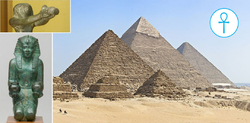- Retour accueil
- Vous êtes ici : Blog The Pyramids of the Cold The Pyramids of the Cold Section 21 • Osiris and the Tibetan Prayer Wheels' Too Lazy Snakes
The Pyramids of the Cold Section 21 • Osiris and the Tibetan Prayer Wheels' Too Lazy Snakes
Publié par Bruno Coursol dans The Pyramids of the Cold le 28/08/2022 à 18:42
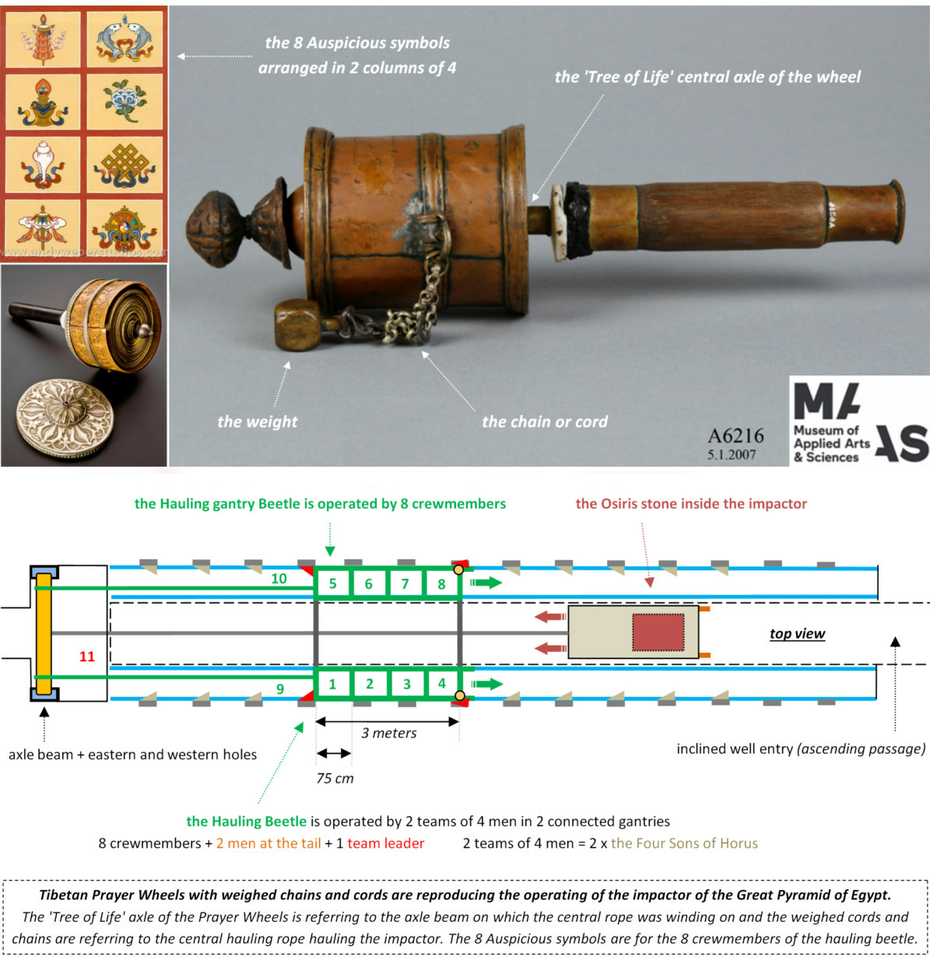
Tibetan Prayer Wheels constantly giving to too lazy Naga snakes small amounts of merit are reproducing the hauling of the impactor of the Great Pyramid of Egypt, pounding endlessly the inclined well still waters.
A Tibetan prayer wheel at the Museum of Applied Arts & Sciences, Powerhouse collection : https://collection.maas.museum/object/185526
Buddhist prayer wheel, Tibet, 1601-1900, Wellcome Collection at the Science Museum, London : https://wellcomecollection.org/works/ewt83spb
The Eight Auspicious symbols by Andy Weber studios : https://andyweberstudios.com/product/composite-of-eight-auspicious-symbols/
The Pyramids of the Cold Section 21 • Osiris and the Tibetan Prayer Wheels' Too Lazy Snakes
In summary : there were two main problems I couldn't figure out and that are crucial for the global understanding of the religious glorification of the operating of the Great Pyramid : what really was representing Osiris and what metaphor was used to represent the granite weight that was inserted inside the wooden part of the impactor.
I searched for months in vain the response for these two major individual problems, and I never thought that they were each other's solution : Osiris is the metaphoric glorification of the granite weight that was inserted inside the wooden part of the impactor. Osiris is a stone, the most important of all; and like the endless pounding of the waters of the inclined well had been the origin event of the Churning of the Ocean Hindu myth, the Osiris stone also had been the origin of another mythology of its own : the Osiris stone is the weight of the Tibetan Prayer Wheels.
We've seen in Section 19 that the Churning of the Ocean Hindu myth is a complete reinterpretation of the operating of the inclined well of the Great Pyramid of Egypt : the endless pounding of the waters of the well being described as the churning of these waters to create pressurized water. In this Section we'll see that the Tibetan Prayer Wheels are all about the functioning of the counterpart of the well : the Grand Gallery, where a Hauling gantry beetle was constantly pulling back the impactor from its initial floating position inside the well to the upper part of the Gallery, ready to be released one more time into the steep slope and pressurize the well.
We'll see that the most important part of the Prayer Wheels is its weight and that it is all about the Osiris stone.
The function of the Tibetan Prayer Wheels is not just about saying prayers or mantras, but about giving "small amounts of merit to lazy Naga spirits"; Nagas referring to snakes. The fact is we've already seen that in the ancient Egyptian religion snakes were only metaphors of the water from the Nile that powered up the Great Pyramid; so if Prayer Wheels are somehow giving small amounts of merit to lazy snakes, it means that these small amounts of merit are actually given to lazy water.
Lazy water is water without energy : it means that "Lazy Naga Snakes" are referring to Still water and that the small amounts of merit given to that water are actually referring to small amounts of energy, constantly given over and over again to that Still water.
Tibetan Prayer Wheels, just like the Churning of the Ocean Hindu myth, are referring to the operating of the inclined well, but the Prayer Wheels are focusing on the impactor and how it was operated : their design with a "Tree of Life" axle and the weighed chain or rope are a perfect match of the entire apparatus of the Grand Gallery where the act of Hauling the impactor was performed. The winding mantras on the axle "Tree of Life" perfectly reproducing the winding of the impactor's central rope on the axle beam. Even the 8 crewmembers of the Hauling beetle are somehow referred to by the 8 Auspicious Symbols that are most of the time depicted on the Prayer Wheels.
The Prayer Wheels' design and the Too Lazy Naga snakes myth are crucial for their understanding, but mantras or prayers are also very important, and if the origin of Prayer Wheels is all about ancient Egypt and the Great Pyramid, then these prayers would also refer to that same origin.
The fact is that they do : there is one particular ancient Egyptian god who was known as "the god who listen to prayers", and that is Ptah, the creator god who "crafted the world in the design of his heart". We've already seen in Section 19 and 20 that every time ancient Egyptians were talking about the Heart, they were referring to the Heart of the Great Pyramid : the inclined well; so Ptah creating everything from the design of his Heart, means that creation started in the well.
Ptah is the inclined well. Creator god Ptah is the glorification of the well of the Great Pyramid.
21.01 The impact of the Great Pyramid on the ancient World
I first need to emphasize one more time how puzzled I am about discovering bit by bit that everything I've wrote on ancient Egypt, has actually been "reused" in other civilizations like the Māori indigenous Polynesian people of mainland New Zealand (Aotearoa) in Section 7 (Bes, the glorification of the wedging block of the Great Pyramid) as well as in the Churning of the Ocean Hindu myth (Section 19).
What really needs to be pointed out is that ancient Egyptians had over time acquired a very high knowledge of what we call today Low Tech; but they accomplished this tour de force, surrounded by other civilizations who didn't and who were still pretty much living in the stone age.
No civilization other than the ancient Egyptians would have ever been able to impress the rest of the world that way. The imprint of the operating of the Great Pyramid of Egypt on the ancient World was so strong that many myths were born because of it; and it happened all over the world.
The Hauling of the impactor in the Grand Gallery (the "Secret Hauling Cavern of the Underworld"), the pressurization of the waters of the inclined well (snakes with weight upon them) and the fog of microdroplets (the Dendera Light) that created the cold by simply evaporating, everything had been glorified and worshiped in Egypt, but also all over the ancient world.
It happened in New Zealand, in India, in Cambodia and it also happened in Tibet with the Prayer Wheels and the Lazy Naga snakes, and it always concerned the most important part of the pyramid : the inclined well. Many myths that appeared in the ancient World outside Egypt are about the inclined well. Maybe most of them are.
Many people trying to decipher ancient Egypt outside the box, are playing with the idea that electricity is the key, but it is not : the key is pressurized water.
And the Tibetan prayer Wheels are all about that : the lazy Naga snakes that need to get 'merit', should I say 'energy', is all about pressurization of water. Like in ancient Egypt, snakes were metaphoric representations of water, and lazy snakes were just plain still water.
Tibetan Prayer Wheels are about how was pressurized the water of the well.
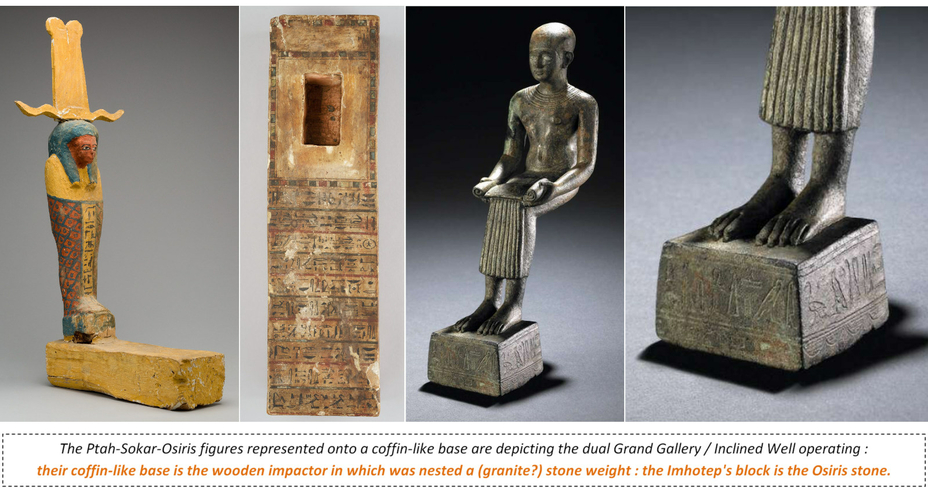
Ptah-Sokar-Osiris Figure of Ankhshepenwepet, Dynasty 25 (Kushite) at the Metropolitan Museum of Art, New-York : https://www.metmuseum.org/art/collection/search/548279
Also at the MET, the Ptah-Sokar-Osiris Figure Dedicated to a temple musician named Ihet, it is inscribed with offering prayers and texts glorifying the gods : https://www.metmuseum.org/art/collection/search/553823
Bronze seated figure of Imhotep at the British Museum : https://www.britishmuseum.org/collection/object/Y_EA40666
21.02 In the Osiris myth, the coffin is about the wooden part of the impactor... and Osiris himself is the stone weight
Osiris' deciphering had been for me like a mosquito hunt when you can hear it's sound but you can't neither spot or kill the poor thing. At the same time I'd been trying to find how ancient Egyptians had represented the so important granite weight of the impactor, but in vain… until today. I'd killed the mosquito, and I'd killed Osiris, the metaphoric glorification of the Great Pyramid of Egypt impactor's granite weight.
It really is amazing, I was looking for more than a year now what was the metaphoric representation of the granite block that was inserted inside the impactor; one of the most important block of the entire operating Great Pyramid, and I actually literally had it right under my eyes since the very beginning… but I guess it wasn't the right time.
I think I was looking for something that in some way 'looked like' a granite block, or another animal like Taweret but I should have known better and keep analyzing the myths more accurately, because the solution of this so particular granite block is in the Osiris myth : the Osiris coffin "made to fit Osiris exactly" is the wooden cradle float part of the impactor and Osiris is the inserted granite block that was nested inside the wooden coffin of the impactor of the Great Pyramid.
"In the Osiris myth, Osiris was killed by Set by being tricked into a coffin made to fit Osiris exactly. Set then had the coffin with the now deceased Osiris flung into the Nile." https://en.wikipedia.org/wiki/Djed
The wooden cradle float (most probably made of very hit and weather resistant Ficus sycomorus wood, Section 10) was just the vessel for this granite block : the boats of the Underworld are all about this vessel.
"Osiris is the god of fertility, agriculture, the afterlife, the dead, resurrection, life, and vegetation in ancient Egyptian religion." [...]
"Plutarch recounts one version of the Osiris myth in which Set (Osiris' brother) […] conspired with 72 accomplices to plot the assassination of Osiris. Set fooled Osiris into getting into a box, which Set then shut, sealed with lead, and threw into the Nile." https://en.wikipedia.org/wiki/Osiris
21.03 The Grand Gallery's axle beam was most probably made of super tension resistant Tamarix wood
"Later myths tell a story in which the evil god Set killed Osiris, put him in a coffin which he threw into the Nile. The coffin became embedded in the base of a tamarisk tree of life, which became a pillar in a king’s palace." https://www.landofpyramids.org/tree-of-life.htm
"The coffin became embedded in the base of a tamarisk tree of life, which became a pillar in a king’s palace." is priceless, because not only in the story about evil god Set, is appearing a wooden pillar, but we also learn that this pillar was made of Tamarix (also Tamarisk or Salt cedar) wood : that is the axle beam of the Grand Gallery these myths are talking about.
We've already seen that the impactor was certainly made of Sycamore (also Sycomore) Ficus sycomorus tree (the Sycamore tree putting its weight upon the Great Serpent Apep), probably the most hit and weather resistant of all wood species. Could the axle beam of the top platform of the Grand Gallery had been really made of Tamarix wood?
According to Wikipedia, Tamarix wood was used in ancient times to make 'tremendous powerful bows' : it means that it is a wood which is super resistant to tension, whether that tension is coming from the string of a Saka bow, or from the central hauling rope of the impactor.
"The Tamarix wood was used by the Saka (combined with wood and ibex horn) to produce tremendously powerful bows hundreds of years before the common era." https://en.wikipedia.org/wiki/Tamarix
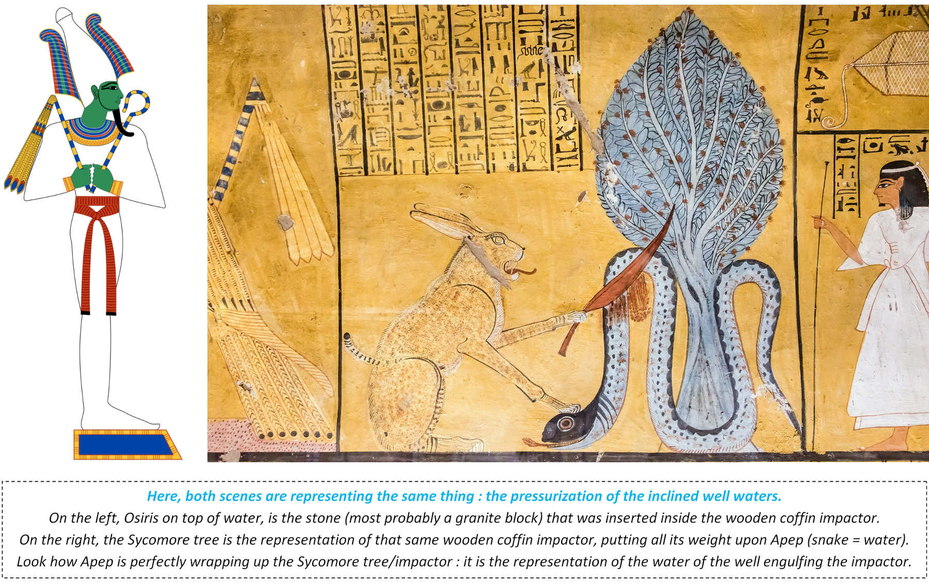
Osiris, the ancient Egyptian god of 'Rebirth, Fertility and Agriculture' drawn by Jeff Dahl : https://en.wikipedia.org/wiki/Osiris
Apep being cut into pieces with a knife by the great cat Mau (the Great Cat of Heliopolis), photographed by kairoinfo4u in the tomb of Inherkau TT359 : https://www.flickr.com/photos/manna4u/18390398199/in/photolist-2jvGusa-uiKg1k-u26AF2-YbXiKr-XzWp6J
21.04 The boat race between Horus and Set is about the wooden and stone composite design of the impactor
The Osiris myth about the wooden coffin trickery involves Set as the bad guy, but there is no mention of any stone that would have add a lot of weight to the wooden coffin. Hopefully, there is another myth where Set is also the bad guy : it is the myth about the fight between Set and Horus. In this myth, the wooden coffin is replaced by a wooden boat that has to compete against a boat made of stone.
"… the other gods were getting tired from over eighty years of fighting and challenges. Horus and Set challenged each other to a boat race, where they each raced in a boat made of stone. Horus and Set agreed, and the race started. But Horus had an edge: his boat was made of wood painted to resemble stone, rather than true stone. Set's boat, being made of heavy stone, sank, but Horus' did not. Horus then won the race, and Set stepped down and officially gave Horus the throne of Egypt." https://en.wikipedia.org/wiki/Horus
In this Horus and Set myth, it is mentioned that the fight between the two of them lasted for over 80 years; if this data is a genuine one it could refer to 80 years of experimentations before the evaporative cooling was mastered, but it is most probably a wrong track.
Anyway, this myth is talking about the design of the impactor : if it was only made of wood, the impactor wouldn't have gain enough energy to pressurize the well; but if it was only made of stone, it would have sank at the bottom of the well and would have rested against the Taweret sealing block.
The perfect impactor had to be made of both wood and stone, this is why Horus won the race. Because they couldn't say that the stone was actually supposed to be nested inside the wooden part of the boat, the myth is only about a boat made of wood but painted to resemble to stone.
Of course, I only assume that this stone was made of granite, the best high quality stone available.
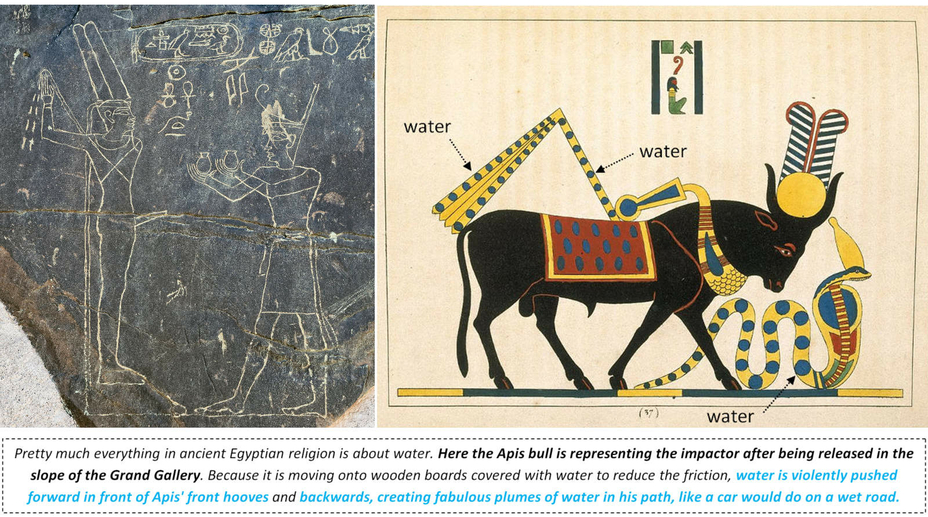
Relief at Wadi Hammamat showing that the flail symbol is all about water. Middle Kingdom Dynasty 11, Nebhepetre Mentuhotep II. Photographed by kairoinfo4u : https://www.flickr.com/photos/manna4u/25932728632/in/photostream/
Api or Hapi (Apis, Taureau Consacré a la Lune)", 1823-25. Printed material. Brooklyn Museum : https://www.brooklynmuseum.org/opencollection/archives/image/55326
21.05 The fabulous frontwards and backwards plumes of water accompanying the descent of the impactor
Pretty much everything in ancient Egyptian religion is about water, and the flail is no exception as we can see it in the "street artist" piece on the above Wadi Hammamat relief. Here the Apis bull is representing the impactor after being released in the slope of the Grand Gallery.
Because it is moving onto wooden boards covered with water to reduce the friction, water is violently pushed forward in front of Apis' front hooves (snake = water). But water is also projected backwards, creating fabulous plumes of water in the path of the speeding impactor, like a car would do on a wet and very slippery road.
The flail is a beautiful artistic representation of the water plumes that gushed out of the impactor's trail, but the water pushed frontwards is also very well rendered : the snake almost looks like little ripples in the water, don't you think?
Look at the Bull's gaze direction, it seems like he is also pushing frontwards the snake with his head.
21.06 The feathers of Shu on the head of the Apis bull is about the air being pushed in front of the impactor
Not only we can see that the Apis bull (probably a representation of the entire structure of the impactor, but also maybe simply another representation of the Osiris weight stone) is pushing water with his lower part in contact with the 'floor' with its front hooves, but we can point out that Apis also has on his head the feathers of Shu, the god of dry and warm air. It could be the confirmation that the impactor was also pushing air in front of him, and it was really moving into a fixed wooden caisson that extended the inclined well into the Grand Gallery.
The impactor not only pressurized the waters of the well, but it also worked like a bicycle pump by injecting fresh dry air into the evaporative cooling passage.
In previous posts I suggested that the wooden ramp that connected the Grand Gallery with the inclined well had hollowed air slots, but I'm wondering if it was even necessary : the air could have simply been forced into the well before the impact and redirected towards the cooling passage just like pressurized water a few moments later.
In the next paragraph, we'll see that the same feather of Shu also appear on the head of the Awakening Osiris, and this time there is no confusion possible : Osiris is not the entire structure of the impactor, Osiris is only the inserted stone weight.
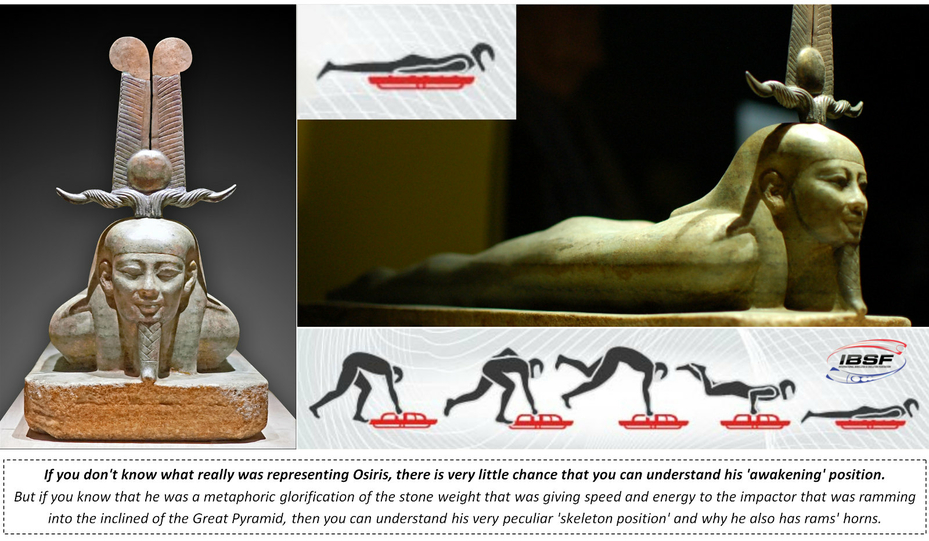
Le réveil d'Osiris (the Awakening of Osiris) at the Exposition Osiris, Institut du Monde Arabe, by Jean-Pierre Dalbéra and Gautier Poupeau
Skeleton infographic by the International Bobsleigh and Skeleton Federation : https://www.ibsf.org/en/our-sports/skeleton-info-graphics
21.07 The Awakening of Osiris' skeleton position is about pushing air frontwards and ramming into the well
If you don't know what really was representing Osiris, there is very little chance that you can understand his 'awakening' face-down and head-first riding position.
But if you know that he was a metaphoric glorification of the stone weight that was giving speed and energy to the impactor that was ramming into the inclined well of the Great Pyramid, then you can understand his very peculiar 'skeleton position' and why he also has rams' horns.
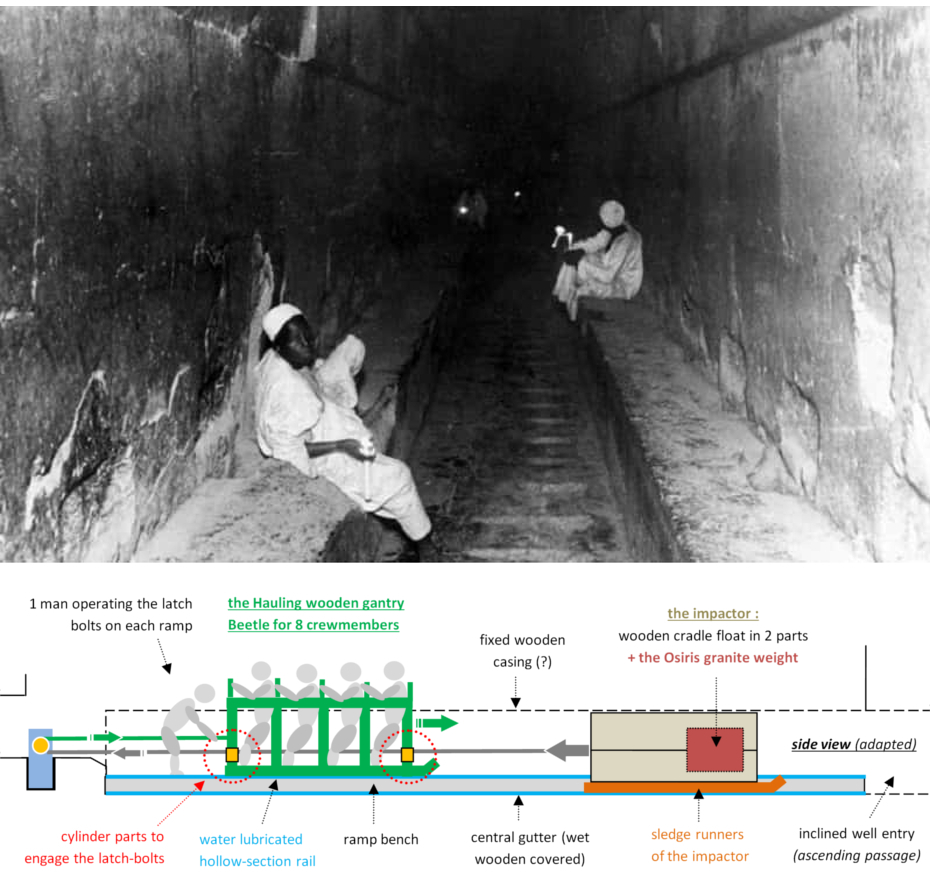
The operating of the impactor of the Great Pyramid of Egypt. The Grand Gallery is the "Mysterious Hauling Cavern of the Underworld".

'Osiris on his Funeral Bed', Egyptian Museum, Cairo (JE32090); Photo: Christoph Gerigk © Franck Goddio / Hilti Foundation. Saint Louis Art Museum : https://www.slam.org/audio/sunken-cities/
21.08 Osiris' death and rebirth is about the impactor's operating cycle : its slow ascent and its lightning descent
On the above left image, is represented the descent of the impactor, gaining speed and energy, hence the aerodynamic 'skeleton position' of Osiris (the 'awakening of Osiris').
On the right image is the sequential hauling of the impactor : Osiris looks 'dead' because he is doing nothing, he is just a deadweight painstakingly towed to the top of the Grand Gallery, pair of latch bolts after pair (the triangular Sokar falcon representations are the latch bolts, Section 11). Look how the bottom falcons (the 'live' latch bolts that were actually holding the hauling beetle, step after step) are tight grasping Osiris' feet : Osiris' feet are 'locked' between the falcon's wings, just like the Hauling Beetle in the latch bolts.
Also, the fifth falcon onto the body of Osiris himself (described as Isis), probably means that there actually was another type of latch bolt involved : like I've suggested, this latch bolt probably was the system that released the impactor into the slope at the end of the hauling process.
21.09 The 'Funeral Bed' of Osiris isn't the impactor but the Hauling Beetle : the light-brownish impactor is right underneath
What really is important to note about the 'Osiris bed' is that Osiris isn't lying onto the impactor, but on the representation of the hauling beetle : the 'Osiris Bed' is the Hauling beetle, with the Lions' heads.
If you look closely, you'll see that the impactor is actually also represented : it is the grayish structure that is right under the black basalt 'Hauling Bed'.
And it is also the exact layout assembly that I've drawn for months now : the Hauling beetle was moving just above the fixed caisson where was the impactor.
The heads and paws of the Lion are indicating the direction of the hauling.
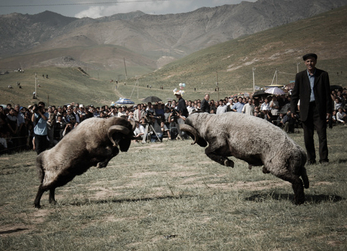
The only purpose of Osiris, the Osiris' stone, was to ram into the inclined well waters with the highest speed possible. But by doing so and during the fall inside the fixed wooden caisson extending the well, air is pushed in front of the impactor : this is why not only Osiris is wearing rams' horns but also feathers, the feathers of god of dry warm air Shu.
What is incredible about the Skeleton winter sliding sport, is that the analogy with the impactor of the Great Pyramid is absolutely perfect : the wooden part of the impactor is the skeleton bobsled, the stone weight is the skeleton athlete and the constantly dampened wooden covered slippery central gutter of the Grand Gallery where the impactor was moving is the frozen track.
Ram fighting, National Games, Shahrisabz, Uzbekistan : https://commons.wikimedia.org/wiki/Category:Ram_fighting
What is even more surprising is that we can see today the analogy between the movement of the impactor and the movement of the skeleton on the ice, but we also know that cold was what really was happening just next to the Grand Gallery, inside the cooling passage. How cool is that! And how cold did they really get?
How efficient really was their 'pressurized' evaporative cooling process?
Today, it looks like only 'adiabatic' evaporative cooling is used all over the world : that is realizing the process at atmospheric pressure; but is there anyone pressurizing air in the evaporative process anywhere?
If you pressurize the air, it means you have more air per unit of volume : you can force more water into the air. The more air you have, the colder it is gonna get.
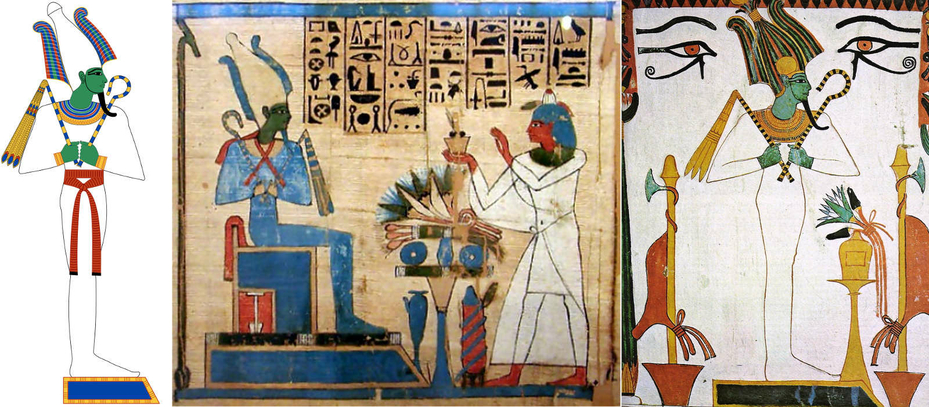
Ancient Egyptian god of Rebirth and Fertility Osiris, draw by Jeff Dahl : https://en.wikipedia.org/wiki/Osiris
The god Osiris receiving offerings, Hieratic Book of the Dead of Padiamenet (22th Dynasty) photographed by Jon Bodsworth, and in the tomb of Sennedjem (19th Dynasty) by Iniati. Both images on https://fr.wikipedia.org/wiki/Osiris
21.10 Osiris, the stone weight of the wooden impactor
In short : when it is said in the Set and Osiris myth that "Osiris was killed by Set by being tricked into a coffin made to fit Osiris exactly" and that "Set fooled Osiris into getting into a box, which Set then shut, sealed with lead, and threw into the Nile", it means that Osiris is the weight that was inserted inside the wooden coffin impactor.
And when it is said in the Set and Horus myth where they challenged each other to a boat race, that Horus' boat "was made of wood painted to resemble stone, rather than true stone", it means that the weight of the impactor was made of stone, and that Osiris was that stone.
21.11 The metaphors depicting Osiris as the impactor of the Great Pyramid
The ancient Egyptian religion is nothing but an accumulation of metaphors and the Osiris myth is not different. Osiris being the representation of the granite stone that was inserted into the impactor and which rammed, or penetrated the inclined well waters, some of Osiris' stories are mentioning some kick that Osiris would have give to Set, or some sexual intercourse that Osiris may had have with Set's consort. The intercourse metaphor is one of the most often used by ancient Egyptians, and here with the impactor's operating, it is a very accurate one, also because of the water splashed that followed the impact with the waters of the well :
"Some versions of the myth provide Set's motive for killing Osiris. According to a spell in the Pyramid Texts, Set is taking revenge for a kick Osiris gave him…"
"… whereas in a Late Period text, Set's grievance is that Osiris had sex with Nephthys, who is Set's consort and the fourth child of Geb and Nut."
We've already seen that crocodiles and bulls were also metaphorical representations of the impactor, and in the following excepts, Osiris is precisely identified as these two animals.
I actually very often mention the 'impactor' as the wooden structure where the Osiris stone was lodged in, but I'm starting to think that ancient Egyptians didn't care that much about this wooden part. For them, the 'impactor' was the 'Osiris stone' :
"In some cases the texts suggest that Set takes the form of a wild animal, such as a crocodile or bull…"
The idea itself of Osiris that was representing the stone of the impactor, being thrown into the waters of the inclined well where it sank before being retrieved and pulled back up into the Grand Gallery, is also clearly mentioned in Egyptian texts (don't forget that all the water that was used to power up the pyramid was coming from the Nile, and so were the waters of the well) :
"… in others they imply that Osiris's corpse is thrown in the water or that he is drowned."
All excerpts from Wikipedia's page on Osiris : https://en.wikipedia.org/wiki/Osiris_myth

21.12 Was the crook the tool used to retrieve the impactor from the well?
The wooden part of the impactor, made of Ficus sycomorus wood (Section 10) was only designed so that the impactor would be able to gain speed and energy in the slope of the wooden covered floor of the Grand Gallery, but also to facilitate its operating and its retrieving in the inclined well : the impactor was either floating completely or would have stay in mid-water, depending on its global density.
Maybe the crook was the tool used to catch the impactor when it was resting in the well, floating in shallow depth.

The ancient Egyptian mummification, by SimplisticReps: https://upload.wikimedia.org/wikipedia/commons/1/17/Mummification_simple.png
21.13 The Osiris stone's bandages were assuring a perfect fit with the wooden caisson
Osiris was classically depicted as a green-skinned deity and partially mummy-wrapped at the legs, and I first thought that the mummy-wrapped legs were another metaphor and that they simply represented the fact that the Osiris stone was nested inside the wooden coffin : the layers of bandages would have reproduced a kind of nest.
But this metaphor didn't satisfy me : it is an easy one, and it is a bad one.
We've seen that the impactor wooden part was made of Sycomore wood and that they had to hollow it out so that the Osiris stone would perfectly fit into it. But I'm wondering : how perfect really was the fit?
Because if you know that the impactor would have to endure thousands and thousands of hits into the waters of the well, you know that the Osiris stone and its wooden coffin have to behave like one single impactor : there can't be any gap anywhere between the two of them.
I think ancient Egyptians really wrapped the Osiris stone into bandages before putting it inside its wooden coffin.
The Osiris stone was the most important block of the Great Pyramid : the hauling beetle only goal was to lift this stone and it is this Osiris stone that pressurized the waters of the well as well as the evaporative cooling passage with the air the impactor moved in front of its descent.
I think that if Osiris and every single mummy is wrapped into bandages, this is only to reproduce the bandages that wrapped the Osiris stone inside the impactor. If I'm right about this, it means that the sarcophagus that are protecting the bandages-wrapped mummies, are only reproducing the wooden coffin of the Osiris stone.
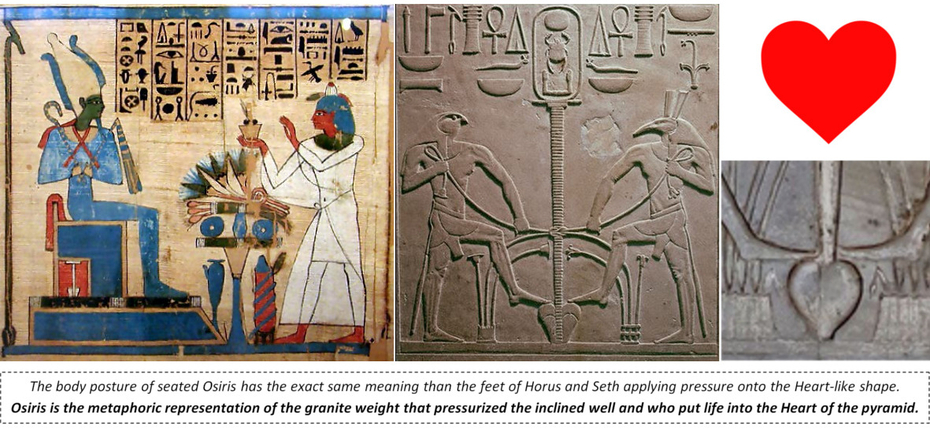
"Hapi (left), Horus and Set (center), performing the Sema-Tawy ritual (lotus and papyrus entwined; the unification of Upper and Lower Egypt)". Traditionally this is a ceremony performed by Hapi, God of the annual inundation of the Nile. https://fr.wikipedia.org/wiki/Deux_Terres#/media/Fichier:Luxor_Tempel_15.jpg
21.14 Osiris is the granite weight that pressurized the inclined well and gave life to the Heart of the Great Pyramid
The body posture of seated Osiris has the exact same meaning than the feet of Horus and Seth applying pressure onto the Heart-like shape : with his weight, seated Osiris is applying pressure onto the Heart-like shape.
More on the origin of the Heart shape being the inclined well of the Great Pyramid, in Section 19 'The Churning of the Ocean Hindu myth' and Section 20 'The Weighing of the Heart myth'
21.15 Is the Osiris green color referring to green granite?
The other characteristic feature of Osiris is the unusual green color of his skin. Now that we know that Osiris was nothing else than a stone, maybe this color is a genuine data that can help us determine what kind of stone was Osiris made of.
Every single important stone of the Great Pyramid is made of granite, and I can't imagine that the most important stone of all wouldn't have been made of granite as well : green granite is maybe the answer.
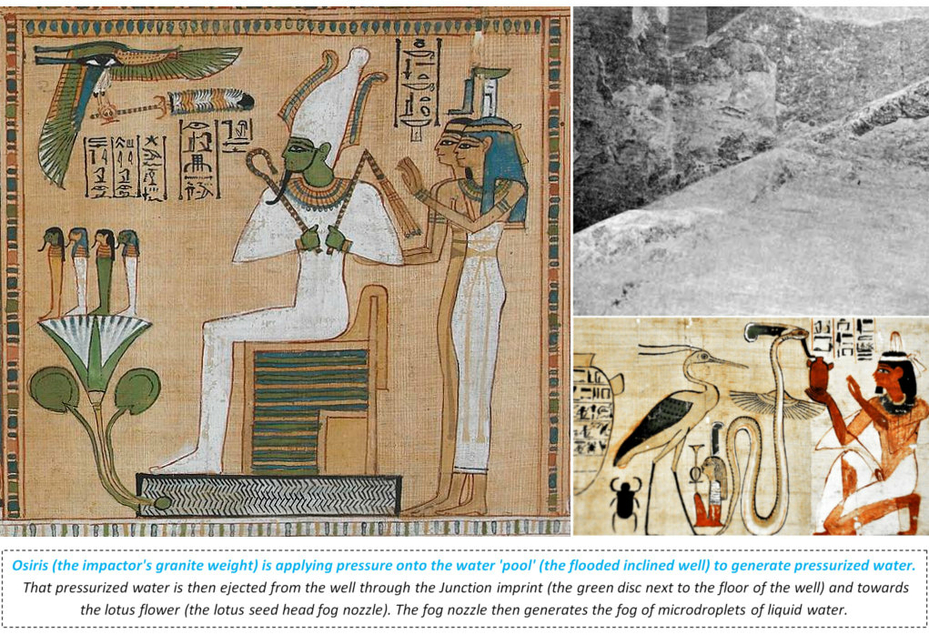
Book of the Dead of Hunefer at the British Museum : https://www.britishmuseum.org/collection/image/753627001
21.16 The entire sequence of the cold creation : Osiris impactor's weight / Water / Junction imprint / Lotus 'flower' Seed head
The representation of Osiris in the Book of the Dead of Hunefer is a perfect illustration of the entire sequence that generated the evaporative cooling fog : Osiris is applying pressure onto the water 'pool' (that is the exact same thing than Osiris seated on top of the Heart-like shape in the Book of the Dead of Padiamenet), the pressurized water then passes through the Junction imprint (the circular hole) and the Lotus 'flower' seed head that is the fog nozzle of the cooling passage.
In the right bottom image, I'm assuming that this is the same Junction imprint from which pressurized water is getting out and transforms itself into the snake. If I'm right about this scene, this particular snake would be Atum : the small amount of pressurized water (maybe about 200 liters) ejected from the well every 15 minutes or so.
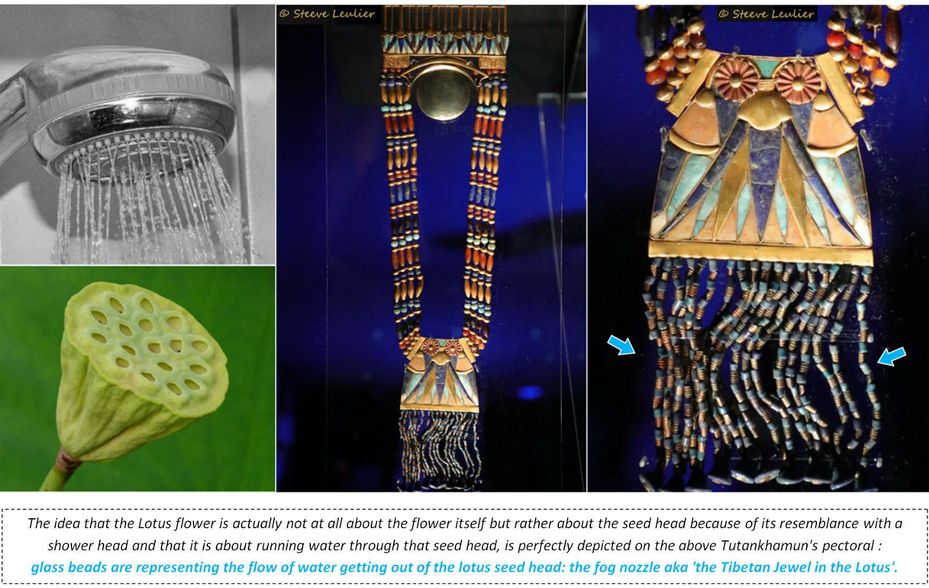
Shower head thanks to Nicole Koehler : https://commons.wikimedia.org/wiki/File:Shower_head.JPG
Pectoral of Tutankhamun photographed by Steeve Leulier : Exposition Toutânkhamon : le Trésor du Pharaon
21.17 The trickling water from the lotus 'flower' seed head in King Tut's pectoral
The idea that the Lotus flower is actually not at all about the flower itself but rather about the seed head because of its resemblance with a shower head and that its meaning is about running water passing through that seed head, is perfectly depicted on the above Tutankhamun's pectoral : numerous glass beads are representing trickling water getting out of the lotus 'flower' seed head.
The Tibetan 'Jewel in the Lotus' mantra really is a metaphoric glorification of the fog nozzle of the Great Pyramid.
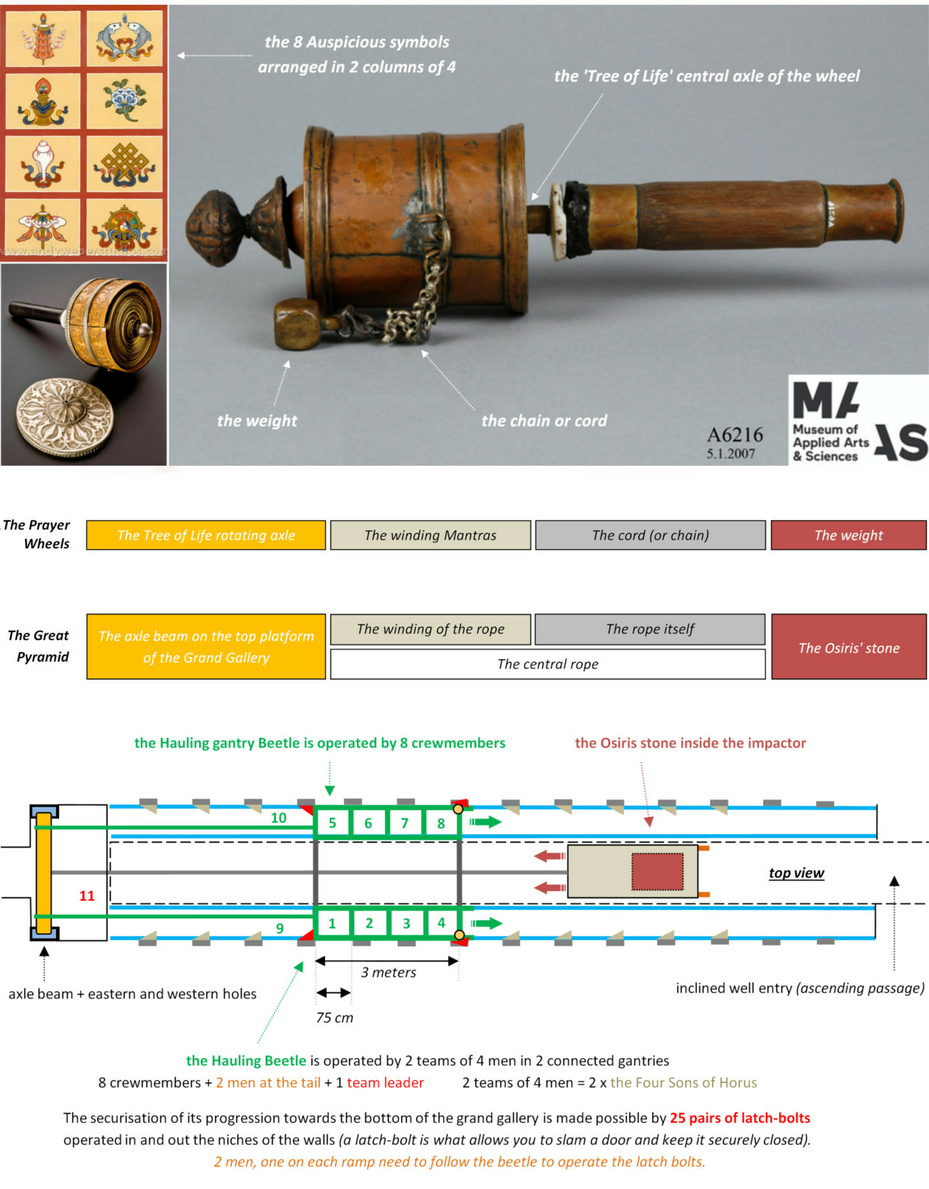
21.18 Prayer Wheels were originally intended to constantly give small amounts of 'Merit' to Too Lazy Naga snakes
The function of the Tibetan Prayer Wheels is not just about saying prayers or mantras, but about giving "small amounts of merit to lazy Naga spirits"; Nagas referring to snakes. The fact is we've already seen that in the ancient Egyptian religion snakes were only metaphors of the water from the Nile that powered up the Great Pyramid; so if Prayer Wheels are somehow giving small amounts of merit to lazy snakes, it means that these small amounts of merit are actually given to lazy water.
Lazy water is water without energy : it means that "Lazy Naga Snakes" is referring to Still water and that the small amounts of merit given to that water are actually referring to small amounts of energy, constantly given over and over again to that Still water.
"The prayer wheel, a popular device in Tibet and across the Himalayas, was originally intended for the Naga world, where the serpent-like creatures were too lazy to engage in meritorious acts.
"A common narrative for the origins of the prayer wheel credit Shakyamuni Buddha for teaching a system of religious practice that would allow the very lazy and uneducated Naga Spirits to acquire some small amount of merit by turning in a clockwise direction a cylinder of mantras, dharanis and auspicious verses."
https://www.himalayanart.org/search/set.cfm?setID=562
"According to one story of their origin, the philosopher Nagarjuna obtained the prayer wheel from the king of the serpentine beings known as Nagas, who in turn received them from the Buddha Dipamkara. The Naga king described the prayer wheel as the “profound Dharma wheel that can liberate sentient beings from all the suffering of the 3 lower realms by merely seeing, hearing, remembering, or touching.”
https://rubinmuseum.org/collection/artwork/wind-powered-prayer-wheel-20.406
21.19 The Too Lazy Naga snakes and the Egyptian primordial 'inactive' still waters are the same thing
Again, both ancient Egyptians and the Tibetan prayer Wheels are describing the same thing when the first ones are talking about the 'inactive' primordial waters, and the second ones about the 'too lazy' snakes that need small amounts of 'merit' to exit their lazyness.
From Wikipedia : "Nu (also Nenu, Nunu, Nun), feminine Naunet (also Nunut, Nuit, Nent, Nunet), is the deification of the primordial watery abyss in the Hermopolitan Ogdoad cosmogony of ancient Egyptian religion."
"The name is paralleled with nen "inactivity" in a play of words in, "I raised them up from out of the watery mass [nu], out of inactivity [nen]". The name has also been compared to the Coptic noun "abyss; deep". https://en.wikipedia.org/wiki/Nu_(mythology)
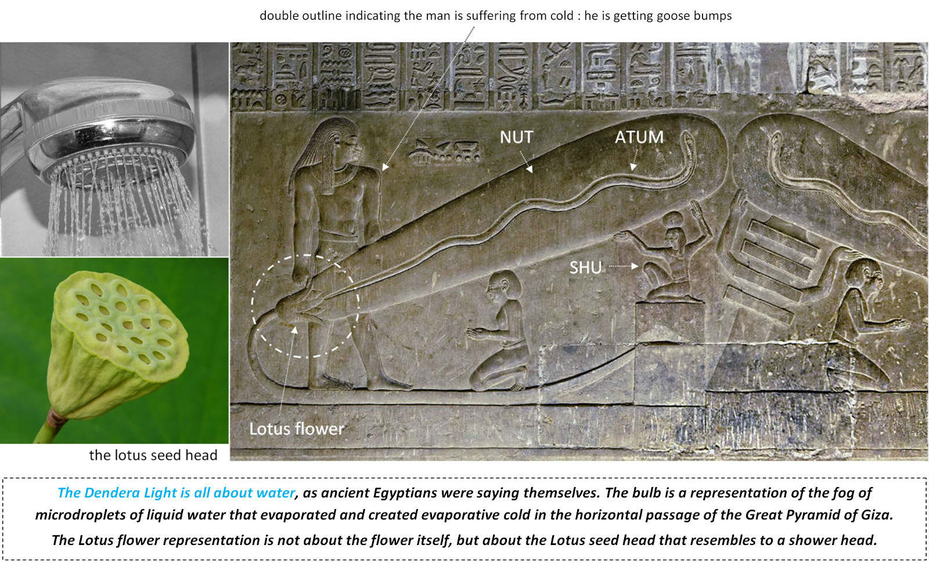
The Dendera Light relief in the Hathor temple, photographed by Kairoinfo4U and posted on flickr : https://www.flickr.com/photos/manna4u/14525094039/in/photostream/
Lotus seed head image thanks to Dinkum : https://commons.wikimedia.org/wiki/File:Nelumbo_nucifera_%28fruit%29.JPG
21.20 The "Om mani padme hum" mantra, literally "the Jewel in the Lotus" is the glorification of the fog nozzle of the Great Pyramid
"Om mani padme hum" is most probably the most important mantra of all; its meaning is : “the jewel in the lotus”.
We've already seen in Section 2 about the Dendera Light that the lotus flower from which the bulb is getting out is a representation of the fog nozzle that was set at the entry of the horizontal cooling passage : the representation of the lotus flower isn't about the flower itself, but about the lotus seed head that resembles to a shower head.
The meaning of the lotus flower is about running water passing through the Jewel of the Lotus : the fog nozzle of the pyramid.
The Tibetan "Jewel in the Lotus" mantra is the glorification of the fog nozzle of the Great Pyramid of Egypt.
"Prayer wheels larger than human size are to be seen in separate rooms in Tibetan Buddhist temples and can be set in motion by pilgrims. With the help of a small bell the number of revolutions can be counted. The cylinders of fixed prayer wheels are often inscribed with the formula “Om mani padme hum” (meaning “jewel in the lotus”) in ornamental Lantsa (Ranjana) letters." https://en.wikipedia.org/wiki/Prayer_wheel
21.21 Prayer Wheels are all about the Grand Gallery and the operation of the impactor
We've seen in Section 19 'The Churning of the Ocean Hindu myth' , that both the artistic representations and the myth itself, were indicating that the origin of the myth was the Great Pyramid and mostly the inclined well.
Here for the Prayer Wheels deciphering, we have the same dual thing : both the design of the wheels and the myth about them are indicating their origin, and it is still about the pyramid, but this time it is all about the Grand Gallery and the operating of the impactor.
21.22 The cord/chain and the weight : the central rope operated impactor
It looks like modern interpretations of Prayer Wheels only see in the weighed chain of the handled models, a simple accessory that facilitates the use of the wheel, but it is a profound mistake : everything about the Prayer Wheels indicate that the chain (or the cord) is referring to the central rope of the Grand Gallery; the rope that connected the axle beam of the upper platform to the impactor and ensured its hauling from the inclined well.
21.23 Prayer Wheels are only meant to be spinned clockwise
This information about the Prayer Wheels, hence the Tree of Life having to be spinned clockwise could be of some interest : it could indicate that when the impactor was hauled up to the top part of the gallery, the Tamarix axle beam would have also rotated clockwise.
Knowing the tremendous impact all the Great Pyramid operation had in Egypt and all over the ancient World, it is even possible that this is the origin of the definition of the clockwise direction of rotation itself.
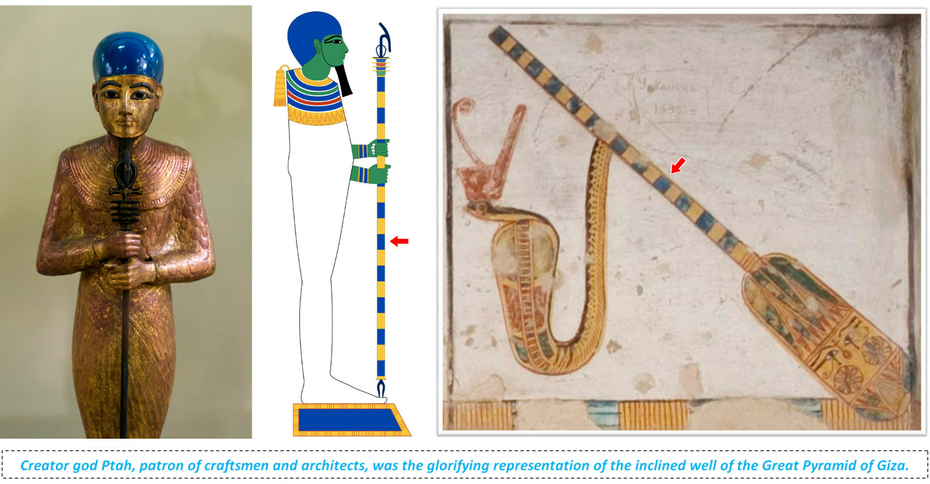
Statue of god Ptah, photographed by kairoinfo4u : https://www.flickr.com/photos/manna4u/26774477850/in/photostream/
"Ptah, in the form of a mummified man (except for arms and face) standing on the symbol for Ma'at, holding a scepter or staff that bears the combined ankh-djed-was symbols" and drawing of the Creation god Ptah by Jeff Dahl on Wikipedia : https://en.wikipedia.org/wiki/Ptah
Photograph from tomb KV 11 of Ramesses III, side chamber, image # 21076 by Matjaz Kacicnik, courtesy of ARCE, American Research Center in Egypt in partnership with the American University in Cairo Egyptology Department : https://thebanmappingproject.com/images/21076jpg
21.24 Ptah the patron of craftsmen and architects because of the inclined well design
As the representation of the inclined well of the Great Pyramid, the creator god Ptah has been identified with the patron of craftsmen and architects.
The well was the most advanced piece of equipment ever built, in some ways it could be compared to a modern engine cylinder, and the impactor to the piston of that engine. The structural integrity of the well was ensured by the 14 Girdle stones that probably are the biggest blocks of the pyramid, even bigger than the top platform of the Grand Gallery.
But this particular aspect of the engineering of the well was minor : there are only 3 girdles in the upper part of the well; and the impactor certainly didn't go much farther down.
All the other face to face Girdles at the bottom of the well were only there to ensure that the draining of the well wouldn't be jeopardized by the constraints supported by the structure. This part can be compared to modern reinforced concrete : nothing could have been allowed to move even an inch so that the Taweret block could free the drain hole. The Taweret block absolutely needed to slide freely towards the 'Savior' shock absorber granite plug #2.
Please, take just one minute to imagine the whole thing : the Bes block had to break under a precise amount of pressure to let the Taweret block slide with the water… then the tremendous sound when Taweret hits the Savior block… and the sound of all that water gushing out of the well into the Al-Ma'mun cavity.
No wonder Ptah had been identified with the patron of craftsmen and architects and was linked with Imhotep, sometimes himself represented on the Osiris' stone weight.
"Ptah (Ancient Egyptian: pth) is an ancient Egyptian deity, a creator god and patron of craftsmen and architects. In the triad of Memphis, he is the husband of Sekhmet and the father of Nefertem. He was also regarded as the father of the sage Imhotep."
21.25 Ptah's hollow scepter is the inclined well representation
In the above image and in most of his representations, Ptah is holding a blue and yellow scepter or staff that bears the combined ankh, djed and was symbols.
This blue and yellow 'staff' is actually the representation of the inclined well of the pyramid, and the reason why the ankh, djed and was symbols seem to be nested into that 'staff' is only to indicate that it is hollow : the 'staff' is the inclined well and the dotted blue line is about the movement of water .
The representation of the well held by Ptah is always in a perfect vertical position, but its true nature is shown in the tomb of Ramesses III : it has pretty much the same slope than the Grand Gallery/ascending passage layout.
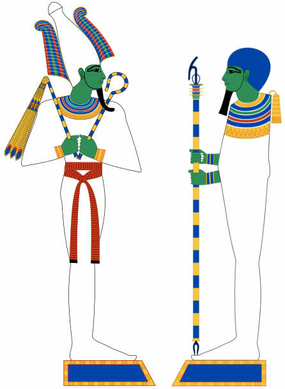
21.26 Osiris and Ptah are indissociable : they are parts of the same unit
If ancient Egyptian gods Osiris and Ptah are represented in a very similar way, that is because they were actually working together, like an engine motor.
Osiris was the piston and Ptah was the cylinder. You can take these parts apart, but they don't have any interest separately. It looks like for the Egyptians that what I'm calling the 'impactor' wasn't the composite wooden coffin with the nested granite Osiris stone, but the Osiris stone only. The wooden part was only a simple vessel : the many boats represented everywhere in the Underworld are the representations of this vessel. Boats in the Underworld = the wooden coffin of the impactor.
Osiris is represented still, but the flail indicates that he is moving at high speed (the flail is the representation of water plumes projected at the rear of the Apis bull), ready to ram into the inclined well that Ptah is holding.
21.27 Ptah "Who Listen to Prayers" and the Prayer Wheels are about the same 'Prayers'
We've seen that the Prayer Wheels' design and 'operating' were all about giving small amounts of merit to Too Lazy Naga Snakes and that it has to deal with the operating of the impactor of the well; but the prayers or mantras themselves are important, they are crucial; but if nobody is here to hear these prayers, what's the point, right?
The fact is that in ancient Egyptian religion, there is actually one god who precisely "Listen to Prayers", and this god is Ptah.
"In the New Kingdom, the cult of the god would develop in different ways, especially in Memphis, his homeland, but also in Thebes, where the workers of the royal tombs honoured him as patron of craftsmen. For this reason, the oratory of Ptah who listens to prayers was built near the site of Deir el-Medina, the village where the workers and craftsmen were housed. At Memphis, the role of intercessor with humans was particularly visible in the appearance of the enclosure that protected the sanctuary of the god. Large ears were carved on the walls, symbolizing his role as god who listens to prayers." https://en.wikipedia.org/wiki/Ptah
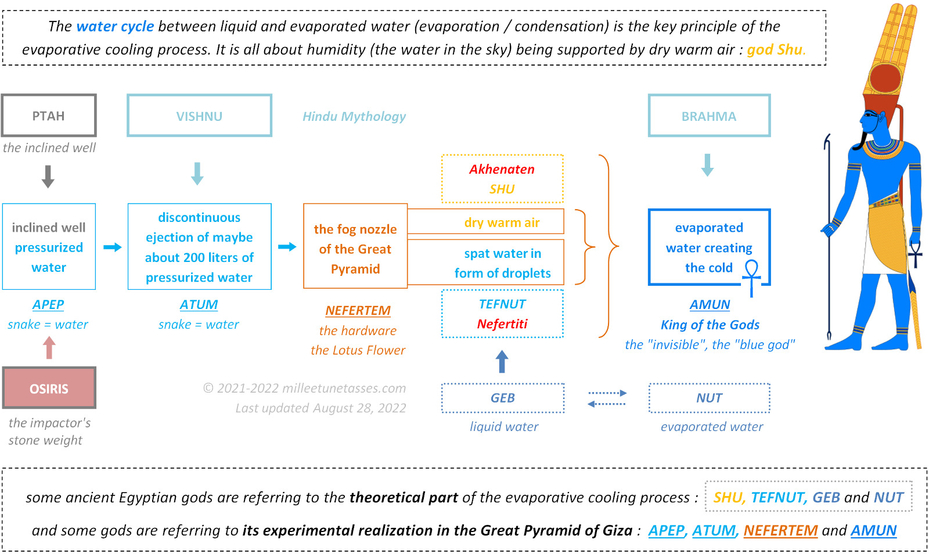
The theoretical and experimental Egyptian gods involved in the evaporative cooling process, including Ptah, Atum and Tefnut.
21.28 Ptah constantly referring to the Heart is the glorification of the Heart of the Pyramid : the inclined well
We've already seen many times that the inclined well was metaphorically represented into a functioning living Heart, so when creator god Ptah is constantly referring to the Heart, he is referring to the inclined well. And that is the link with the Tibetan Prayer Wheels, or more precisely the Prayers are the link between Ptah and the Prayer Wheels : both are about the inclined well and both are listening to the Prayers.
Every single Prayer coming from the Prayer Wheels and listened to by the ancient Egyptian creator god Ptah is about one single cycle of the inclined well operating : one Prayer = one pressurization of the Well = one creation of the evaporative fog creating the cold.
In the following excerpt, Ptah is being linked to some of the ancient Egyptian gods that are referring to the evaporative cooling process : Atum and Tefnut ('tf' meaning to spit). More on Nut and Tefnut in Section 3
"He created the universe by speaking words through his Tongue (linked to the god Thoth and the goddess Tefnut) and by thoughts coming from his Heart [...]. There came into being as the heart and there came into being as the tongue ... in the form of Atem (Atum)." http://www.touregypt.net/featurestories/ptah.htm
21.29 The creation of the myths about the inclined well
It is very hard to imagine what really looked like the pyramid when operated, but certainly as I've already discussed many times in posts previous to 'The Pyramids of the Cold', the Great Pyramid wouldn't have been completed; it would have pretty much looked like the lower part of the Bent Pyramid, and if this Bent Pyramid is precisely in 2 parts, it must certainly has to be related to that lower Great Pyramid part for cold production.
But if the impactor hit the waters of the well every 15 minutes and if the Grand Gallery was somehow close to be in midair, the sound of the whole thing would have been heard probably kilometers away.
Everybody in ancient Giza would have been able to hear it, 10 hours a day, every 15 minutes for most probably a period of 4 months (Section 20). Residents of Giza would have heard it but also everybody coming to Giza from foreign countries : visitors, merchants, domestic and foreign dignitaries, etc.
Of course, the biggest impression would have been caused by the breaking of the Bes wedging block and the release of the Taweret block resulting in the tremendous shock with the Savior block (granite plug #2).
Everybody heard it, and everybody talked about it. This is how the inclined well inspired so many myths in the ancient World.
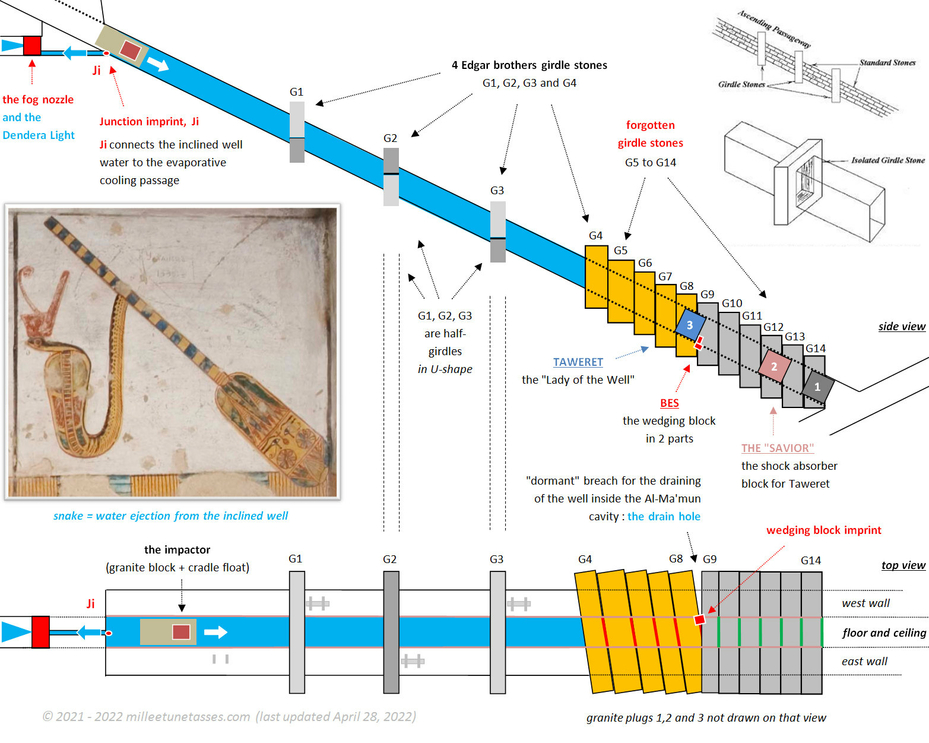
21.30 The layout of the girdle stones in the inclined well of the Great Pyramid of Egypt
The inclined well, also known as the 'ascending passage' or 'first ascending passage', is represented with its 3 granite plugs in their initial positions; the position they got during the entire operating period of the pyramid for cold production.
More on the girdle stones layout, the Edgar Brothers' forgotten girdles and the granite imprint for the Bes wedging block in Section 4
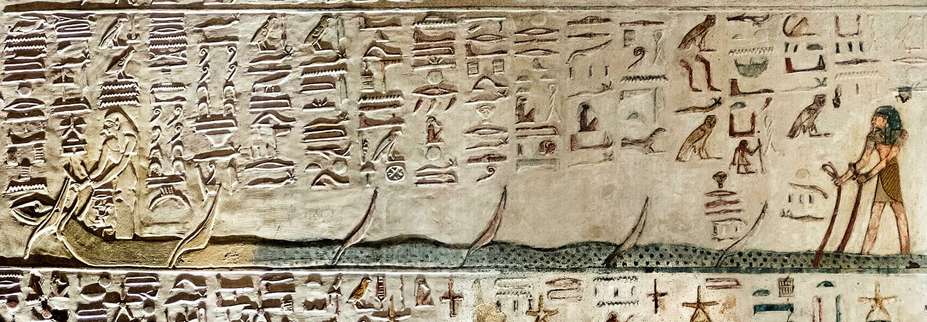
21.31 The cutting of the Great Serpent of the Underworld Apep in multiple pieces (over and over again...)
Relief from KV 17, the tomb of Sety I. Photograph thanks to kairoinfo4u : https://www.flickr.com/photos/manna4u/36879934835/in/photolist-2jvGusa-uiKg1k-u26AF2-YbXiKr-XzWp6J/
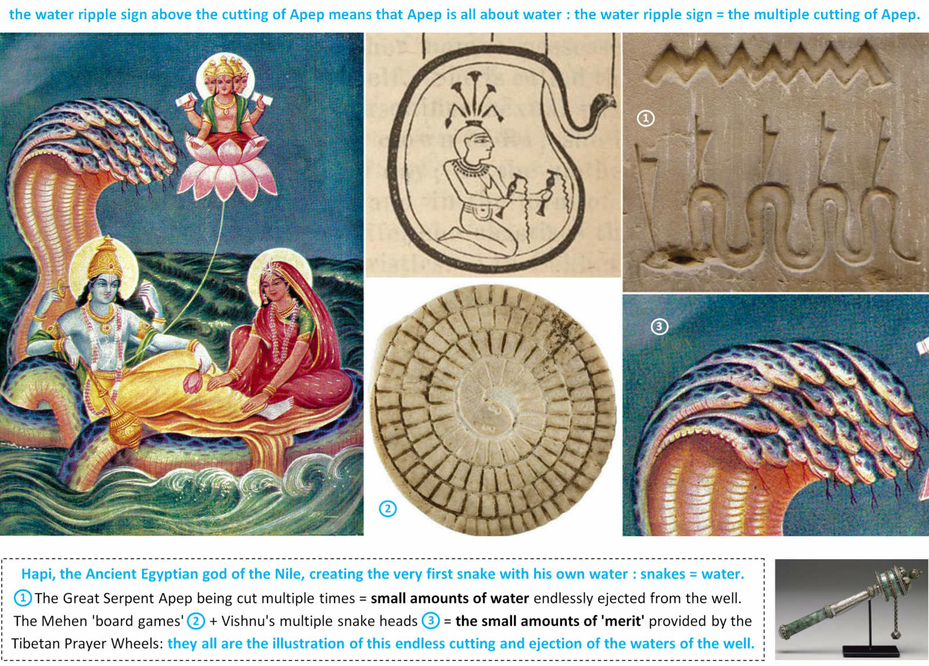
Wall relief of Apep being cut multiple times, temple of Edfu, Egypt, thanks to Rémih on Wikipedia : https://fr.m.wikipedia.org/wiki/Fichier:Edfu16.JPG
21.32 The endless sequential production of pressurized water
In the above images are combined some of the most important metaphors used in the ancient Egyptian religion as well as in some of the rest of the ancient World.
The primordial metaphor is about the representation of the water used to power up the Great Pyramid into snakes, and that it is the ancient Egyptian god of the annual inundation of the Nile who is telling us that he was the one who created the snakes : the water was coming from the Nile.
The second metaphor is about the endless ejection of the inclined well's water that was represented into the multiple cutting of these same snakes. Apep is the original version of this cutting, while the Great Serpent on which Vishnu is sited on, is the Hindu 'version' of this process : the multiple heads' snake is the same thing than the ancient Egyptian Mehen 'board game'. The multiple cutting of snakes = multiple ejection of pressurized water.
The small amounts of merit given to Too Lazy Naga snakes is the way that the pressurization had been represented in the Tibetan Prayer Wheels. Merit = energy = pressurization. The prayers are referring to these sequential pressurizations, over and over again.
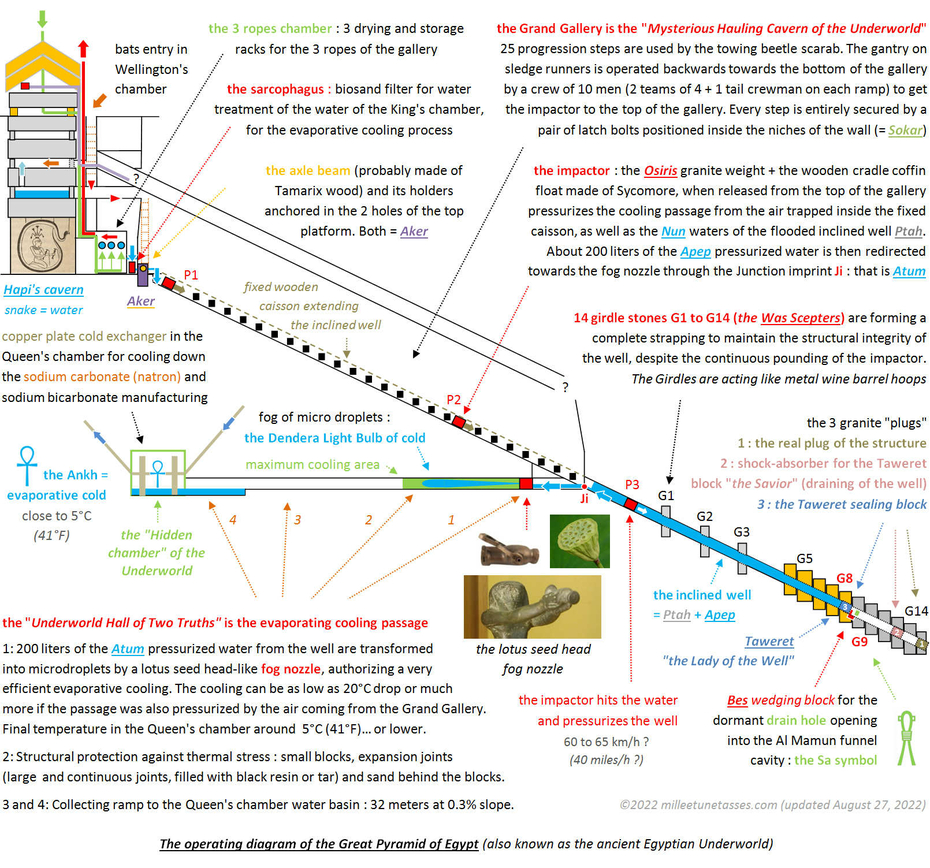
21.33 The Great Pyramid of Egypt in operation, before the shutdown procedure and the draining of the well
Last update August 27, 2022 : minor adjustments + implementation of the Osiris glorification of the impactor granite weight and the Ptah glorification of the inclined well. Ptah is more about the structure of the well, when the Great Serpent Apep is only about the pressurized water that is endlessly cut in small amounts to be injected every 15 minutes or so into the evaporative cooling passage.
21.34 Summary of the study : hidden behind the academic vision of the ancient Egyptian religion, a vast number of metaphors are describing some of the most advanced science and technological knowledge of that time : ancient Egyptian gods were nothing else than pharaohs' metaphoric self-glorifications of their theoretical and experimental scientific accomplishments in physics and chemistry.
Pharaohs used the power of Science to legitimate themselves as kings of Egypt : they forged an entire religion, based on science to rule their kingdom, and they presented that science as Magic.
The end game of this technological program that probably started on the very first Dynasty, was the Great Pyramid of Giza where evaporative cooling was engineered in the known part of the pyramid from the pressurized water produced in the inclined well, known today as the ascending passage.
The evaporative cold simply took advantage of the power of water, and was most probably necessary to cool down chemical manufacturing of sodium carbonate and sodium bicarbonate produced by an ammonia-soda Solvay process, as suggested by the very strong ammonia smell and the limestone kiln in the so-called burial chamber of the Red Pyramid. At that time, sodium carbonate was called natron, and it was the salt used for the mummification of the pharaohs (Sections 14, 15 and 16).
The cooling seems to have represented the most difficult part of the process, as suggested by the Step Pyramid's official name : according to scholars, the very first pyramid complex, the Step Pyramid of Djoser, was called "the refreshment of the Gods". No doubt that a more accurate translation would certainly be "the cooling of the Gods".
It means that ancient Egyptians were the first civilization to master a Solvay-like process for sodium carbonate manufacturing, long before it got reinvented in the 1800's in Europe. The key elements of that process is the temperature control of the chemical reactions (the cooling), and the dome shaped plate necessary for the counterflow chemical reactions to occur in an efficient way. That counterflow reaction plate is what really is the disc of Sabu.
As shown with Akhenaten and Nefertiti, the creation of the evaporative cold was the most sacred accomplishment of all (Section 17), and this is exactly what the Dendera Light is all about : the Dendera Light is the fog of microdroplets of liquid water that evaporates and creates the cold. Talking about the snake inside the Dendera Light Bulb : "The field surrounding Ra’s snake form is referred to in ancient Egyptian literature as protective magical energy in liquid form that all gods and pharaohs possess" (Faulkner, Section 2).
Everything that had been done in the Great Pyramid of Giza inspired most of the ancient Egyptian religion, and it had been glorified into what we know today as the Underworld.
The Underworld is referring to the chambers and passages of the Great Pyramid of Khufu, and in particular to the Grand Gallery where a hauling gantry beetle operated a wooden coffin shaped impactor that had a small nested granite block inside it. The impactor generated endlessly, over and over, maybe every 15 minutes the pressurized water that was then transformed into a fog of microdroplets inside the horizontal cooling passage.
The Grand Gallery of the Great Pyramid where the act of hauling was done, is the "Secret Hauling Cavern of the Underworld" described in the Amduat "Book of the Hidden Chamber".
The most important chamber of the Great Pyramid wasn't the King's chamber that only was the main water tank of the pyramid, but the Queen's chamber, the only one on the central axis of the pyramid. Because the Queen's chamber was inaccessible from the rest of the pyramid, it was glorified into the "Hidden Chamber of the Underworld" (Section 11), and because the Queen's chamber was the coolest place in the pyramid (about 5°C / 41°F), and with a constant 100% Humidity rate, this chamber was the one where the biggest amount of very hard salt encrustation had been documented by the first explorers of the pyramid in the 1800's and before it had been removed in 1998 by Zahi Hawass (Section 1). Very hard salt encrustation is the signature of the evaporative cooling process, even nowadays.
The most incredible thing is that pretty much everything I've just said, actually appears in one single myth, but it doesn't originate from ancient Egypt : it is the "Churning of the Ocean" Hindu myth that produces the immortal nectar Amrita. The fact is that the endless churning of water that ends up with the production of an elixir that gives eternal life, is exactly what were doing ancient Egyptians in the inclined well : natron was the salt used for the mummification of pharaohs.
Natron gave eternal life to pharaohs, just like the Amrita (Section 19).

Water slide thanks to Aquafan (Riccione) : https://granbazzar2017.altervista.org/aquafan-riccione/
21.35 The water slide metaphor of the impactor's operating
I must admit I couldn't find a better illustration of the 2 parts of the operating cycle of the impactor.
The water slide is a perfect modern metaphor, whether it is for describing the sliding movement of the impactor at high speed inside the central gutter of the Grand Gallery; or the slow hauling process to get the impactor back to the upper part of the Gallery.
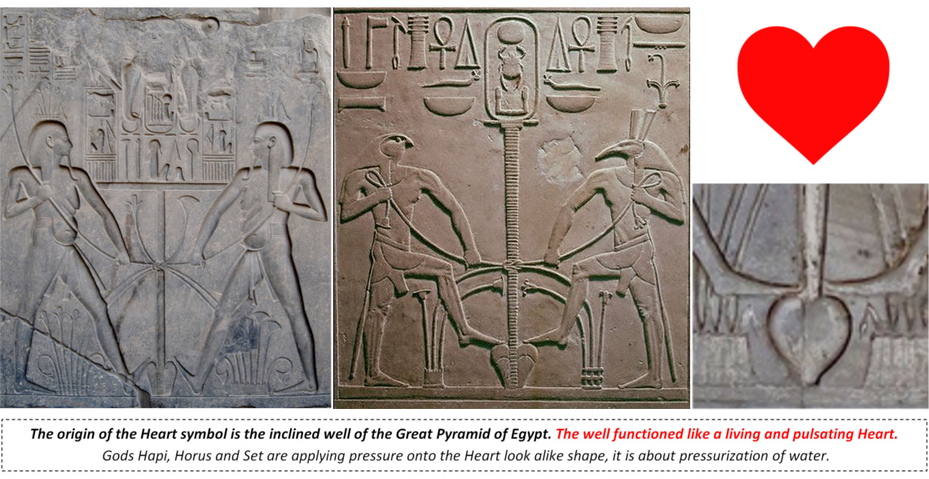
"Hapi (left), Horus and Set (center), performing the Sema-Tawy ritual (lotus and papyrus entwined; the unification of Upper and Lower Egypt)". Traditionally this is a ceremony performed by Hapi, God of the annual inundation of the Nile. https://fr.wikipedia.org/wiki/Deux_Terres#/media/Fichier:Luxor_Tempel_15.jpg
21.36 Was 42 the daily Heart rate of the Great Pyramid of Egypt?
We've seen in Section 19 'The Weighing of the Heart' that when ancient Egyptians were talking about the Heart, they were referring to the heart of the Great Pyramid : the inclined well that functioned like a pulsating living heart.
In the crucial Spell 125 of the Egyptian Book of the Dead it is mentioned that the deceased person has to make a Negative Confession : "The Negative Confession (also known as The Declaration of Innocence) is a list of 42 sins which the soul of the deceased can honestly say it has never committed when it stands in judgment in the afterlife."
https://www.worldhistory.org/The_Negative_Confession/
Knowing that the whole Heart thing is about the inclined well, this number of 42 could be a very important data.
For some time know I evaluated the entire operating cycle duration of the Hauling beetle at something between 10 and 15 minutes, most of that time used to haul the impactor from its resting floating position in the well, up to the upper part of the Grand Gallery next to the top platform.
Let's say the entire team of the Grand Gallery was working 10 hours a day, from 8 am to 6 pm. With a 10 minutes cycle, it would have been possible for them to complete 60 cycles; and with a 15 minutes that number comes to 40 cycles.
It means that working 10 hours a day, the Hauling beetle could have been able to complete 42 complete cycles of a little less of 15 minutes each, assuming the Beetle was never stopped being operated and that the crewmembers would have been regularly relayed.
In short, 42 cycles could have been the daily objective of the Hauling beetle crewmembers.
42 could have been the daily Heart rate of the Great Pyramid of Egypt.
21.37 The Sema-Tawy ritual isn't about Upper and Lower Egypt but about the Upper and Upper parts of the Great Pyramid
We've already seen that the internal layout of the Great Pyramid of Egypt had been glorified into the Underworld. For example the "Secret Hauling Cavern of the Underworld" is the Grand Gallery where the act of towing the impactor was done.
I've also suggested that the Great Pyramid may haven't been completed during its entire operative duration : there was probably like a flat roof at the level of Lady Arbuthnot's chamber level.
It would explain why bat dung and insect's exuviae had been found in this chamber, why the copper tubes on the plates found in the Queen's chamber conduct upper parts had been hammered down and why the King's chamber northern conduct's trajectory suddenly changes at this level.
If I'm right about the reason why the cold was produced, that is for chemical manufacturing cooling of a Solvay-like process, then it would also explain the Big Void found by the ScanPyramids team : the Big Void would be a Red Pyramid like layout with the limestone kiln.
If the Underworld is the lower part of the internal layout of the pyramid, then this hidden upper Solvay-like part would be the upper part of the structure.
The Underworld would be the Lower part described today as Lower Egypt, and the Upper part would be described as Upper Egypt.
The Sema-Tawy ritual is about making the two parts of the Great Pyramid to work together : the production of cold in the Lower Underworld part allowing the chemical manufacturing in the Upper part successful.
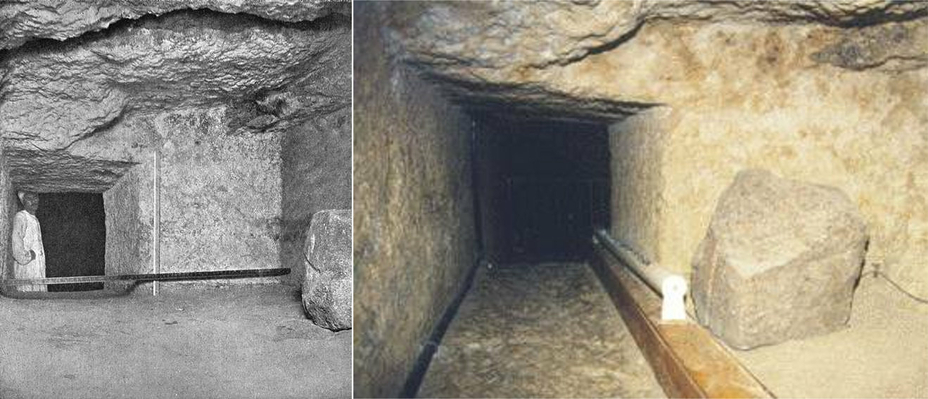
"The Recess cut in the rock to the west of the Small Horizontal Passage of the Great Pyramid of Gizeh, looking south; showing Judah standing in the Subterranean Chamber beyond." Great Pyramid Passages and Chambers, Volume 1 (1910 edition). By John and Morton Edgar. The Edgars were associates of Charles Taze Russell and wrote this treatise in defense of Russell's views on the prophetic symbolism of the Great Pyramid of Gizeh in Egypt. Plate LVIII, page 154 : https://archive.org/details/GreatPyramidPassagesVol11910Edition/page/n161/mode/1up
21.38 Is the Osiris stone still in the Subterranean recess of the Great Pyramid?
In previous posts I've suggested that the granite block that was lodged inside the impactor, the Osiris stone, could have been the granite block found in the subterranean recess. The block is broken so it is hard to imagine it inside the impactor, but most important, I didn't realize the importance of the Osiris block : would this block have been left behind in the pyramid?
What is certain is that if the inclined well was the functional Heart of the pyramid, the Osiris stone was what brought life into it, I don't think the subterranean recess' block is that stone anymore, but who knows.

Tomb of Inherkau TT359, 20th dynasty. Part of the ceiling on the upper chamber. The Theban Tomb TT359 is located in Deir el-Medina, part of the Theban Necropolis, on the west bank of the Nile, opposite to Luxor. It is the burial place of the ancient Egyptian workman Inherkhau, who was Foreman of the Lord of the Two Lands in the Place of Truth during the reigns of Ramesses III and Ramesses IV. https://en.wikipedia.org/wiki/TT359
21.39 Isn't it already an Hindu-like artistic design in the 20th Dynasty's cow pattern in the tomb of Inherkau?
Original photograph by kairoinfo4u and posted on flickr : https://www.flickr.com/photos/manna4u/17956011913/in/photostream/
Poster un commentaire

